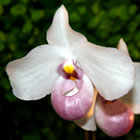Watering Orchids
Over watering is probably the most common cause of failure with orchids. Orchids rot when they are soggy, and mushy or yellow leaves can be a sign of over watering. Water thoroughly, let the flowerpot drain completely, and dry out before watering again.
Tips for Proper Orchid Watering
Imagine how a tropical rainstorm would soak an orchid, drenching it for minutes or hours. A quick splash of water does not give the plant time to absorb enough. Soak your orchid in a bucket or large container so its roots have time to absorb water and fertilizer. Place it in the bowl or container and fill it to the top level of the pot. Let it sit in the water for about 15 minutes. Do not leave it soaking too long, because the roots also need oxygen.
Be sure the water drains thoroughly out of the pot! If part of the plant turns to mush or turns black, you have probably over watered or let the orchid pot sit in water. If the pot sits in a tray, empty the tray after watering. Sogginess causes rot. In their natural environments, orchids are air plants that never sit in water. Germs and other microorganisms that grow in stagnant water can cause orchid roots to quickly die.
- If you are not sure whether or not to water, stick your finger about 1 inch/2.5 cm in the potting media. You may find that even though the top is dry, below the surface it is still damp.
- Another way to determine whether or not to water is to feel the weight that water adds to the pot. Lift the orchid pot after you have watered it to feel how heavy it is when wet. Every few days lift it until it feels light. The lighter weight indicates that it is dry and needs water.
- Some orchids, such as Masdevallias, need to be watered every day. Others, such as Cattleyas, only need to be watered once every two weeks. Most kinds of orchids, including Phalaenopsis, Paphiopedilums, Oncidiums, and Dendrobiums, fall somewhere in between, requiring 2 or 3 waterings a week.
- Use room temperature water. If your local tap-water has lots of impurities or chemicals, use rainwater or filtered water.
- When watering your orchid, the water will run right through the pot. This is because potting media used to grow orchids, like bark and moss, does not hold water the same way that soil does.
- Small pots dry out faster than large ones.
- Some orchids appreciate a dry spell when they are dormant in the winter, and will not bloom without a cooler rest. During dormancy, depending on how quickly they dry out, they may only need water once or twice a month. Do not let them dry out completely, and make sure there is still high humidity.
- At least once a month, flush out the pot with running water for a few moments to clean out accumulated fertilizer residues.
- Mounted orchids may need water several times a day when it is warm.

